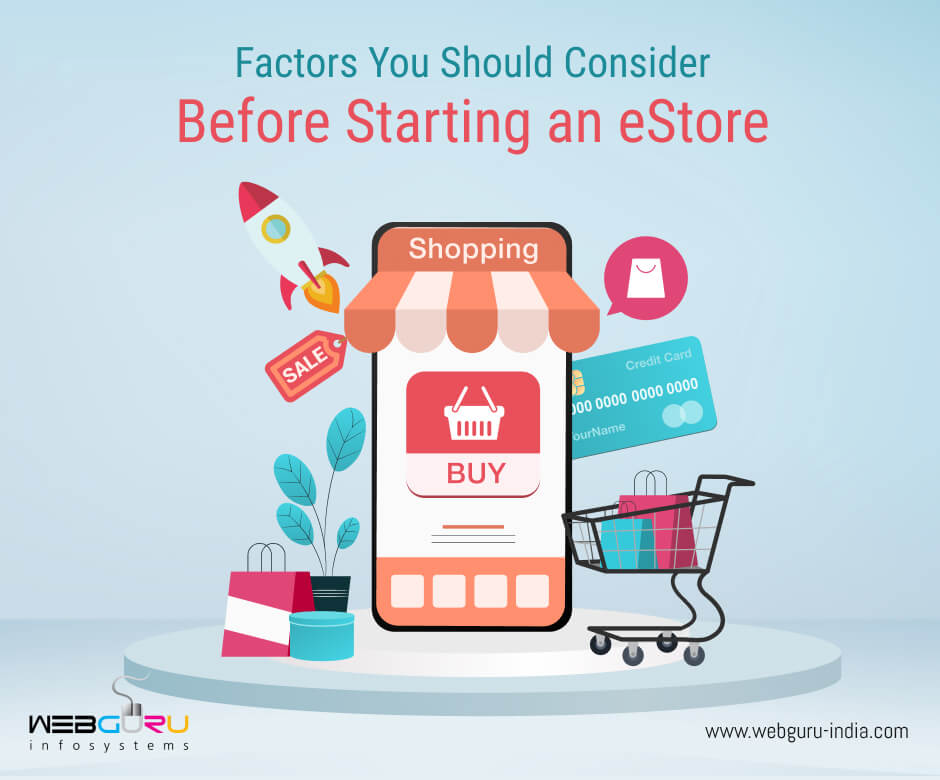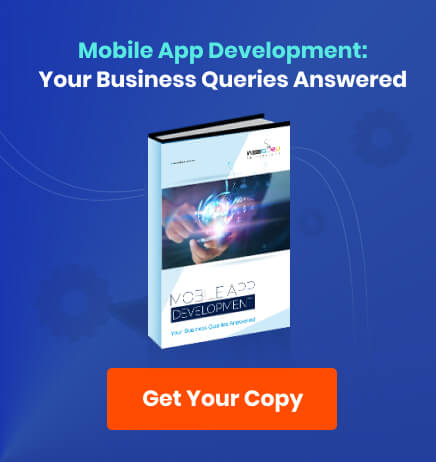Home Blog Ecommerce Website Development 11 Things to Think About Before Venturing into eCommerce
11 Things to Think About Before Venturing into eCommerce
- 06 Sep / 2022
- 2,569 views

The growth of eCommerce has been astounding. There are an estimated 12-24 million eCommerce sites worldwide (WPForms Blog), with more being added everyday. It is an ever-evolving field, with new trends constantly keeping customers hooked to the online shopping experience. Similar to a brick-and-mortar store, launching an eCommerce storefront requires lots of rigorous planning and effort, during pre-launch, launch, as well as post-launch stages. An online store owner needs to consider a number of factors and answer a lot of questions before setting out with eCommerce. Let us have a look at some of them.
Factors to Consider Before Starting an eCommerce Store
Here are some of the factors you have to keep in mind before venturing into eCommerce. Remember that apart from these factors, you will also need a great brand name by which people can remember you. Additionally, the eCommerce application that you finally develop must look and feel top-notch to use in order to stand out from your competitors.
1. Deciding on Products & Services
It is often seen that new ventures in eCommerce begin by mimicking other successful eCommerce business models and services. This isn’t ideal, since you aren’t likely to have the same market research they have regarding their target populations and geographies. It is very important to first find a niche. Even Amazon, the most valuable eCommerce brand in the world, started out by selling books, before venturing out into other products.
Start with a limited number and varieties of products and services that you think you can provide best. This will help you understand the operational processes and have a test run of the market. It is important that your products also be unique, since you aren’t likely to have the resources to provide discounts and other offers that big chains can.
2. Researching Audiences & Competitors
Once you have figured out what to sell, you need to identify exactly who you’re selling it to. Recognizing your target audience involves researching their browsing, buying, and otherwise regular habits. You need to figure out what demographics you’re targeting, what kind of devices they’re using to browse, what their buying preferences are, what their geographies and cultures are, and more. It is only after you have figured this out can you set your business and marketing strategies.
Competitor surveys are also important for understanding the realities of the market. You must identify competitors who are providing the same or similar products/services as you are, and accordingly decide on strategies. Your business planning, financial planning, and production & selling strategies will all depend on the competition you receive.
3. Inventory Management & Stock Tracking
If the goods you’re selling are digital, then you are free from these worries. Otherwise, you must start thinking about warehouse costs, inventory storage and management, and keeping track of your stocks. Leading eCommerce platforms offer inbuilt tools that help you take care of inventory management efficiently. Third party software solutions are available as well, but require you to integrate them into your application. It’s also very important to reflect your stocks on your product pages in real time. This will save shoppers the frustration of not knowing whether the product they want is available or not before the checkout process.
4. Shipping Management
eCommerce businesses usually tie in with several shipping services that will help their products reach their customers both regionally as well as internationally. Of course, the kind of shipping will depend on the target audience base you have chosen. It is important to integrate shipping calculators into your application as well to calculate the final invoice price. This lets customers know the exact amount they have to pay for a product to reach their doorstep.
Third party shipping services will generally provide an API which you will have to integrate, that will also serve as a shipping calculator. If you have your own shipping, then you will have to get your developers to integrate your rates into the application. In case of the latter, it is also smart to invest in distributed warehousing as your business grows. This will save both you as well as your customer shipping costs.
5. Managing Returns
The biggest drawback of eCommerce shopping is that customers can’t physically touch a product before buying it. Which means there’s no way of knowing whether the product is defective or otherwise unsuitable before it arrives. Which is why reputed eCommerce brands always offer options of returns, refunds, and replacements, with a certain amount of flexibility and precautions.
Make sure you have the proper logistics figured out in order to deal with refund or replacement requests. You must be able to have faulty products picked up and the money refunded within a short period of time in order to maintain trust among your customers.
6. Figuring out Monetization
Next, you will have to decide on a price tag on your products and services. This will depend on your investments, ongoing expenditures, worker expenses, application development and maintenance costs, and the minimum profit margins you need to grow your business further. You should take some time and conduct a market research before deciding on your prices. If you frequently change your prices, or keep it the same as your competitors, you won’t come off as a credible business. You need to come up with your own pricing policies that will help you stand out.
7. Choosing the Right Development Team
Once you have the concepts and all the eCommerce mechanisms figured out, you will need quite a bit of time to establish an application from where customers can do their shopping. Thankfully, there’s no shortage of excellent eCommerce development services around the world that simplify the whole process for you. Choose a company that has the requisite experience in building eCommerce applications, and make sure you also check what their clients have to say about them.
8. Website or App
You must decide if you want to create a web application, mobile application, or both. This will affect the rest of the development and other recurring costs you will incur. Based on modern browsing habits and the easy availability of smartphones, mobile apps are perhaps the best way to get people to shop from you. However, mobile app development costs also tend to be higher. If your budget is short, a website is also a great option
9. Development & Technologies
Next, you will have to choose the eCommerce technologies you wish your application to be based on. If you have opted for a mobile app, you need to decide whether you want it hybrid or native. Both have their own characteristics, and your chosen development team can guide you more on what option you should choose.
In case of a website, Shopify, BigCommerce, Magento, & WordPress are great choices. There are plenty of other options, and not all are suited for every kind of business. Talk to your chosen website development company, and understand the pros and cons of all the platforms available to you. Learn about the development costs and further maintenance costs of these platforms, and the kinds of security and extra features they can provide. This will let you know whether you need to invest in additional plugins and extensions for shipping, order tracking, taxes, searching, or something else.
After you’ve chosen the correct platform, you will also have to choose an appropriate hosting service. The kind of hosting service you must go for will largely depend on the number of products you have and the volume of traffic you expect. Aside from development costs, you will have recurring expenses as well in the form of hosting costs, subscription-model plugins, maintenance, and more. Make sure you have a clear idea about the kind of costs you will have to bear before deciding on the technologies you invest in.
10. Marketing
Once you have a decent eStore and fill it with awesome products, you have to market it to your target audience. It is only when you widen your reach and brand awareness that your application will see more visitors, and therefore more conversions. So you will have to plan for not just development but marketing as well, and create a budget accordingly. It is a good idea to hire a professional digital marketing agency for this part, since effective marketing is a time-consuming and complex affair.
Only with a solid marketing plan can you rise above your competitors and become visible to your clients. Talk with your chosen marketing partners and chalk out an effective strategy. Make use of all channels available to you for advertising within your budget, and leverage social media as much as you can. Make business profiles on all appropriate channels, and market regularly to a carefully selected target audience to ensure traffic to your application.
11. Investing in Security
Upto 32.4% (Astra) of all successful online hacking attempts are directed towards the eCommerce industry. Hackers often see new and small eCommerce ventures as easy targets because of their potentially weak security infrastructures. Online shoppers are trusting you with their personal and financial data, and they expect such data to be kept protected. Successful attacks on your application not only make you lose credibility, but can also be potentially dangerous to the people whose data is stolen.
Make sure you stay ahead of such malicious forces by investing in proper cybersecurity measures. Constantly updating all of your admin passwords, keeping your core files and databases updated, and keeping regular backups – all of this can go a long way to keeping your data secure. Conduct vulnerability tests regularly, and use high quality security plugins or external firewall services. Discuss other potential measures with your development team, and ask them to implement the same. Also consider hiring regular maintenance services for your website to keep everything running smoothly.
Conclusion
Your customers should be at the forefront of your eCommerce plans. You can create an excellent shopping experience by making sure your stocking, inventory, shipping, and delivery all happen smoothly. Of course, professional eCommerce development service can boost the quality of your eCommerce business significantly with a high performing, easy-to-use, accessible, well-optimized application. But it is only through careful long-term planning that you can see success in the eCommerce industry.

Rahul Guha
A copywriter by day, a cinephile by night, someone who enjoys playing chess occasionally, and traveling when life becomes a monotonous routine.
5 comments
Leave a Reply

-
1000+
Happy
Clients -
25+
Countries
Served -
19+
Years of
Trust








Nice read. The blog highlights some of the most important factors that you should keep in mind before launching an eCommerce storefront and provides detailed information on each of them. Looking forward to the new post.
An excellent and thorough article on eCommerce venturing. Business owners looking to bring their business online through e-commerce portals should go through the article.
The blog gives a lucid exposition of all the important factors that one needs to consider before venturing into eCommerce. Thanks for this well-written write-up.
Had a great time reading this. A well-written blog and makes some valid points. Look forward to reading more in future.
The success of several eCommerce stores worldwide has kindled interest among entrepreneurs to dive into this world and create value for their customers and business. The blog is quite informative and shall serve as a guide for such entrepreneurs to navigate the world of eCommerce and be successful.